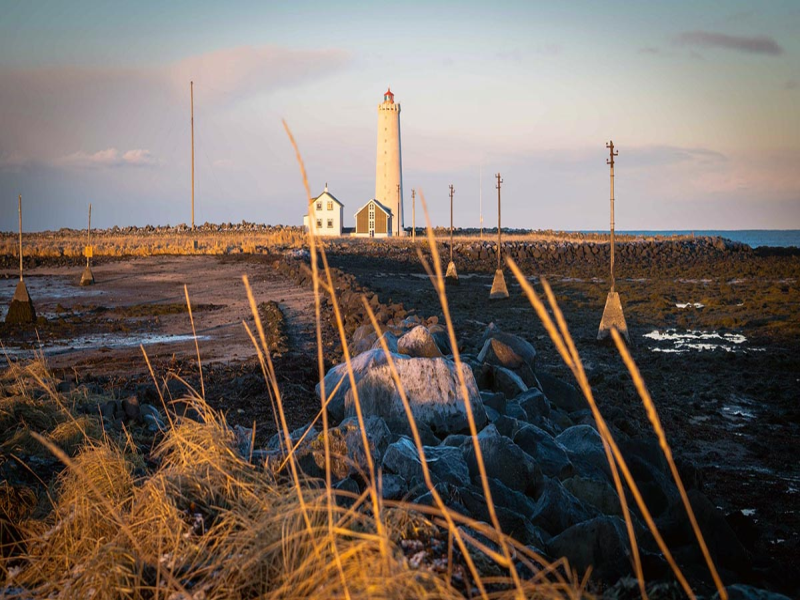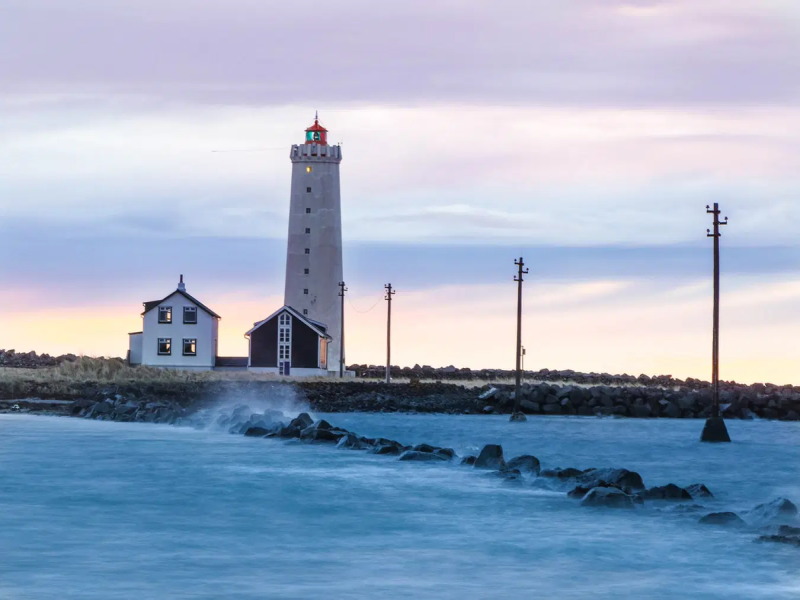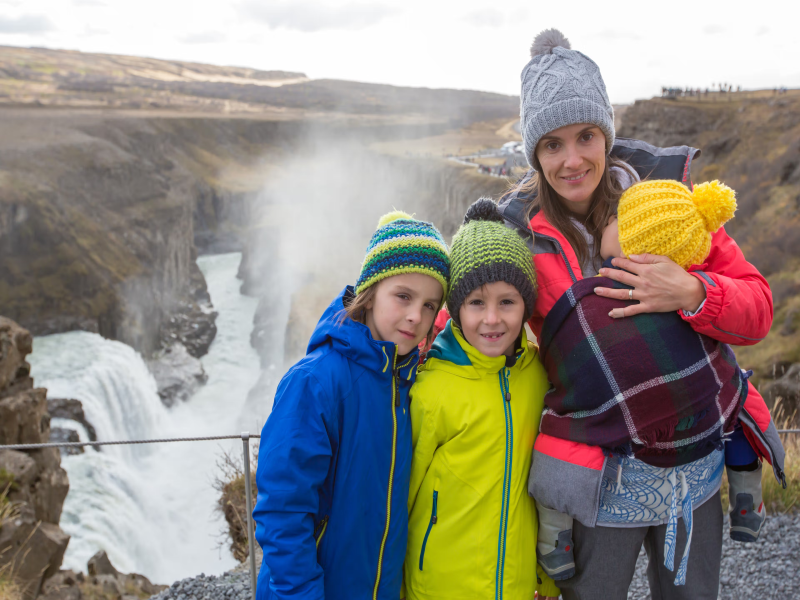Perching at the tip of the Seltjarnarnes peninsula in Reykjavik, Iceland is a zen beacon: Grótta Island Lighthouse. The recognizable white tower and red roof are the highlights of this scenic spot, popular amongst islanders seeking relief from in-town madness.
If you are a natural bird lover, or a photographer looking for stunning landscapes, even someone just wanting to relax in peace with the ocean view, then Grotta Island Lighthouse experience will leave you fascinated.
In this complete overview, we bring you virtually to Grótta Island – offering an insight into what makes it so unique and its diverse wildlife, as well as the incredible activities that await! We will also throw in some tips for making your trip to this beautiful coastal paradise seamless and stress free. So, let us sail towards Grótta Island Lighthouse and find out what it holds!
Note: You have to optimize all images you use within the blog post to make it easy for the web, compressing them without losing quality. Make sure you write a descriptive alt text for every image with relevant keywords like “Grótta Island Lighthouse” & “Reykjavik.”

Discovering Grótta Island Lighthouse: A Natural Haven
The Grotta Island, home to the lighthouse, is a beautiful mix of natural and historical attractions. This small peninsula at the westernmost part of the city of Reykjavík is peaceful and a lovely hideaway from the bustle of the city. The island cold a stunning black sand beach, jagged rocks and a huge tidal flat. These are the ingredients in a dramatic tapestry that changes as regularly as the tides.
Accessible & Experimental Geothermal Footbath:
What makes Grótta Island unique is its accessibility. At low tide, a timeless rock causeway is exposed allowing visitors to walk over to the island. Be aware of the tide schedule before heading to the island, given the causeway going underwater at high tide — potentially trapping visitors who venture along it too long. On the way to the lighthouse you will also come across a lovely surprise — a geothermal footbath. Hidden among the rocks lies this thermal spring that is heated naturally by Mother Earth, perfect to dip sore feet in and to absorb some of the geothermal energy Iceland has to offer.
Bird Sanctuary, Nature Reserve
One of the most picturesque destinations in Reykjavik, Grotta is actually a nature reserve and bird sanctuary. Its variety of habitats, including rocky shores and tidal wetlands draw a wide array of birds, especially during the breeding season. Birdwatcher, and nature lovers will be thrilled to find in Grótta an opulent number of his favorite animals (birds) which continued to live by day in a natural place.
The area of the Grótta lighthouse in a perfect example for how people and nature can live along in a symbiosis with their wild natural elements and the history she left behind from the time when the star-lit night could be ruled by fires or set on flame by lights at human encampments, may it have been you heat source to combat the ravenous Nordic cold or those watching out for enemy arrival.
Whether you seek a gentle walk on the beach, soak in its natural geothermal footbath or to gaze at birdlife in awe — Grótta Island is a captivating distraction that will energise your spirit and catch the flame of adventure.
Next we’ll explore the abundant birdlife around Grótta Island, together making it an eldorado for birdwatchers.
Birdwatching at Grótta: A Paradise for Avian Enthusiasts
Covered in tuff and pseudo crater, the rock is known as Grótta ((Icelandic: Broddi, Lady Island), and will give up its northern tip to the high tide The importance of this place for birds friendship says perhaps a direct quote “,” surely there tropical migration stop but that so. Many bird species, especially migratory birds breeding and resting ground. Whether you are a bird lover or just part-time binocular user, Grótta is busy throughout the year with birds in migration.
Diverse Birdlife:
Birds of many types flock to the island’s many different terrains — from cliffs and dunes, to meadows. Grótta is a hopping place during the nesting season–from May to August– and I only counted two birds because there are hundreds nesting! One of these are the islands many birds, some of you might have seen seeing the following species.
- Arctic Terns -The arctic tern, a seabird with some elegant mating rituals queues and hot blooded behavior, is also sight ready nester on Gro maiden. Their easy-to-recognize key features are those black caps and that bright red bill.
- Puffins/razorbills/fulmars: These striking seabirds are regular visitors to the island throughout the year. They are most prized for their down feathers, which are very soft and used for bedding in luxury furniture.
- Oystercatchers — Striking black and white birds with bright orange bills are frequently seen moving along the shore looking for shellfish.
- Redshanks: Slender wading birds with long red legs and distinctive voices; easily found in the island’s wetland and tidal flat areas.
- Gulls: Several gull species, such as black-headed, common and herring gulls, can be found at Grótta. Their boisterous calls and frivolity lend a youthful addition to the auditory backdrop of the island.
As well as these standard species of birds, more rare birds also come to Grótta Island such as the Eurasian whimbrel, the red-necked phalarope and yes even sometimes a snowy owl. On the Aysén archipelago, a diversity of birds are found on the different islands —a dynamic bird tapestry that offers enthusiastic bird watchers the opportunity to observe migratory and year-round species throughout much of the year.
Types of Travel — Best Times and Places for Birdwatcher
- Nesting Season (May to August) – The island is filled with birds as they are doing their nesting and breeding.
- Morning and Late Afternoon: Birds are most active during the early morning and late afternoon, so those times of day present the best opportunities for observation.
- On the lighthouse and coastline: The area around the lighthouse and along coastline offers great birdwatching locations for gulls, terns (in season), skimmers and wading birds.
- The Pond (Bakkatjörn): Found close to the beacon hell, this little lake draws in a wide range of waterfowl, for example, ducks and swans.
Grótta Birdwatching Tips
- Materials: Binoculars will help you see the birds up close and personal so that you can admire their fun patterns.
- Carry a Bird Field Guide: By carrying a bird field guide, you can easily identify the species you saw and the habits or behaviors of that particular kind.
- Practice Patience and Respect: Observing birds necessitates slowly approaching while being patient. Do not disrupt the birds, especially while nesting.
- Dress appropriately: The weather in Iceland changes quickly, wear layers of clothes and good shoes to walk on rough ground.
Enjoying birdwatching at Grótta Island, on the other hand, is a rich experience which really shows you your place in the natural world and how beautiful and varied birds can be. Both in view and for birdwatchers, Grótta is a truly bird paradise.
Grótta Island Lighthouse: A Photographer’s Dream
Pictured is Grótta Island Lighthouse, an Icelandic gem that you lighthouses may well have seen a zillion snaps of as it’s definitely Heida’s most-photogenic lighthouse with its distinctive architecture and dramatic coastal location giving photographers superb material to point their cameras at on the doorstep of Iceland’s spectacular natural beauty. A traditional red-roofed white tower, the lighthouse stands as a sentinel over the wide Atlantic Ocean, providing a focal point and inspiration to any who cast their eyes upon it.
With its black sand beaches, rugged lava formations and the ever-shifting interplay of light and shadow, the island’s variety of landscapes affords us a vast range of potential imagery. It doesn’t matter if you’re shooting the lighthouse under a burning red morning sky or in complete darkness, engulfed by an eerie fog — either way, Grótta Island will without at doubt provide an awesome backdrop for your photo.
Capturing the Magic:
- Lighthouse: The lighthouse itself can make a great subject… you can take in many different ways and angles. Either shoot it from a step back perspective, and reveal how it responds to the landscape surrounding it or zoom in for all of its own details of intricate designs as well as architectural façades that add its aged texture.
- The Setting: The dramatic view of Grótta Island acts as a beautiful backdrop for your images. Try different angles and perspectives to convey the vastness of the ocean, rugged lava rocks or delicate patterns in the black sand beach.
- The light: Iceland turns out exceptional lighting conditions, especially during shoulder seasons and winter months enabling a magnificent photographic experience. The long hours of twilight, called the “blue hour,” create a soft magical lighting that enrich your images. Also, you might catch the Northern Lights dancing across the sky while they are above the lighthouse.
How to Take Amazing Pictures in Grótta
Best times to shoot Grótta: Sunrise and sunset when the light is lovely and warm, casting long shadows and adding drama. Nevertheless, even better photo prospect is with clear sky as you can see further to the mountains at the other side of bay.
- Think of the tides: The tides are very important for how one can use the landscape in Grótta. When the tide goes out, it reveals the causeway for reaching the island and pools of water that make great reflections. The island is completely surrounded by water during high tide, and we get a very different perspective on the island with tidal pools and waves crashing against the rocks.
- Play around with composition: Try new layout and angles for unique shots Make the viewer look into the image using some kind of leading line like the causeway or the shoreline. Use shallow depth of field to highlight objects, making them stand out against a backdrop or foreground, or shoot wide open to show the landscape that surrounds them.
- Adapt to the Conditions — Do NOT Let Iceland’s weather decide your trip! Accept the elements and leverage them. The fog, the rain, and even the snow can provide beautiful photo opportunities. Finally, don’t forget to keep your cameras covered and dress for the weather.
Because you know the sea will always heed your call, and if drama strikes then Grótta Island Lighthouse is a photographer’s playground. Located in the westernmost tip of Reykjavík, at Grótta (Seltjarnanes), a small peninsula with an iconic lighthouse and various landscapes that provide dreamlike lighting conditions — a recipe for creativity and remarkable imagery.

Exploring Grótta Island: Beyond the Lighthouse
Opposite the Grótta Island Lighthouse is definitely not less-good-view of Kjalarnes and Western Reykjavik Peninsula, but besides the lighthouse; the island itself holds many opportunities for exploration and discovery. Away from the landmark building, you can walk in scenic hiking areas, explore intriguing tide pools, and gaze down on picnic and relaxation spots.
Hiking Trails
The paths over Grótta Island are wide and well-kept, twisting around a variety of landscapes. It have some of the stunning coastal trails of the surrounding, in close view to Reykjavik city on a distant horizon and scenic mountains afar across the bay. On your hike, you will be in contact with several beautiful natural landmarks from the lava formations to crim well hidden coves and volcanic craters. The trails are wide and relatively easy, which makes them accessible for hikers of all levels.
Tide Pools
When the tide is out, low tides offer an opportunity to explore a world of rocky tide pools full of marine creatures. Look closer and find in these mini ecosystems crabs, snails, sea stars, and even baby fish. But be careful and do not disturb the fragile balance of this unique environment
Relaxation and Picnicking
With its tranquil surroundings and all the places to admire, this destination is prime for good relaxation and picnicking on Grotta. Discover a pristine beach, lay out your picnic mat and dine under sunny skies while you get mesmerized by the stunning view of things around you. The gently lapsing waves and calling seabirds form an auditory backdrop that will transport you to tranquil relaxation.
Wildlife Encounters
If you happen to discover Grótta Island on a lucky day, the funny pages of Icelandic native wildlife may introduce themselves. Visitors often spot seals lounging on the rocks or swimming in the waters around them. The island is a great spot for birdwatching, with everything from Arctic terns and eider ducks through to oystercatchers being regular sights just seconds away. Remember to keep a respectful distance and respect the animals in their natural environment.
Environment and Wildlife awareness
Grótta Island is a sensitive environment, so tread carefully and leave no trace. Stay on established trails, pack it in/pack it out and be considerate of nesting birds and other wildlife. So respect the nature around you in order to save some of this beautiful island for the next generations.
The island of Grótta has a world of experiences to offer beyond its lighthouse—capitalizing on the natural sublime + stillness of its coastal surroundings. This beautiful little spot is perfect for a light walk or some tide-pool splashing, but even if you just want to hang on the beach for a bit… chances are you will have fun having created these more than likely lasting memories.
Practical Tips for Visiting Grótta Island Lighthouse
Planning a visit to Grótta Island Lighthouse requires some preparation to ensure a safe and enjoyable experience. Here are some practical tips to keep in mind:
Getting There
If you are located in the center of Reykjavik, Grótta Island is a short walk on foot or bike. The journey will take you 30-45 minutes depending on where you start and how quickly you walk.
By car: If you prefer to travel by car, please note there is a parking lot near the pier where you can park your car. Realize parking is scarce, especially during peak season.
Best Time of Year to Visit
- Shoulder Seasons: Spring and autumn are shoulder seasons when the weather can be mild but there are less crowds to compete with if you want to visit Grótta Island. You also are likely to see migratory birds during these periods.
- SUMMER: This is best for long days (perfect for exploring the island and outdoor activities) … And arguably, heavier crowds and windier weather.
- Winter : During winter the Grótta Island is snow-covered and there are chances of watching northern lights. Beware, though: the weather can be nasty; in a storm the causeway may be icy and/or blocked.
Tide ratings and safety tips
- Look Up Tides: Confirm the tide is going out before setting course onto the causeway. The causeway is open to public traffic only when it is low tide so be sure to give yourself enough time to come back before the tide rises again.
- Footwear: The causeway can be slippery, especially in wet and icy conditions so we have specific footwear which you must wear as part of the safety controls. Make sure to wear shoes with proper tread because this one will likely be a wet and slippery workout.
- Weather: Be prepared for Icelandic weather, even in the middle of summer you can get snowed on, rained on and blasted by fierce winds. Put on layers and bring your waterproof coat.
What to Bring:
Comfortable Shoes: You will do a lot of walking, so wear comfortable shoes for the rocky paths.
Warm Clothes: It gets chilly even in summer on Grótta Island, especially when the wind picks up. Wear and carry lots of layers, a warm hat, and gloves.
Bring your camera: Grotta Island is a photographer’s wonderland with great photo opportunities.
Food and drink — There are no facilities on the island, so grab some snacks for yourself.
To equip if you are a birdwatcher binoculars and guide for bird recognition.
Respect Nature and Animals.
Remain on Established Trails: Only tramp along the trails indicated to maintain fragile vegetation and wildlife.
Leave No Trace: The Rockaway are a fragile ecosystem, if you pack it in, pack it out.
Stay Away from Wildlife: Stay at least 100 feet away from birds and other animals, particularly nesting times when parents may be protective of their young.
Take Care with Nesting Birds During the nesting season (May to August) in particular, please be careful not to scare birds from their nests or young.
Follow these tips to preserve the natural environment, and have a safe, enjoyable and responsible visit to Grótta Island Lighthouse.
Read on to have your questions about Grótta Island Lighthouse answered!
FAQs about Grótta Island Lighthouse – Grótta Island Lighthouse
In order to eliminate any remaining questions, we have put together a list of frequently asked questions regarding Grótta Island Lighthouse:
I see the Grótta Island Lighthouse on the inside?
The Grótta Island Lighthouse’s interior is sadly off limits to the general public. Nonetheless, the exterior of the Lighthouse is still accessible and may be shot from various angles.
Is there a restroom or café on the island? Since Grótta Island is devoid of any facilities, it is best to utilize the amenities at the car park or in central Reykjavik prior to your arrival on the island.
Is Grótta Island suitable for children?
Grótta Island is well-equipped for kids and contains a variety of straightforward walking paths linking up different areas. However, keep a close watch on your kids, especially near cliffs and hide pools, which might be lethal during high tide.
Is it permissible to bring your pet?
Dogs are permitted access to the island yet must be kept under control and secured with a leash at all times.
What Time Of Day Is Good For Photography?
The best period for shooting Grótta Island is determined by the sort of lighting you desire to achieve. The golden hours of sunrise and sunset The “blue hour” of sunset or sunrise The weather, with clear days offering the majority of the island and its spectacular mountains accessible for photos Dark days or rainy days

Conclusion – Grótta Island Lighthouse
Nestled on an unspoiled coast, the lighthouse is buoyed by Grótta Island and surrounded by spectacular views. This is a nice place to visit to relax outside of Reykjavik where you can experience the beautiful landscapes as well, tranquility from the countryside side and the charm from Iceland’s natural wonders.
It is perfect for a casual walk along the coast, bird watching of various kinds of birds (especially great photos) or relaxing walks.
Come see the magic of Grótta Island Lighthouse for yourself by taking an adventure there. Check the tides, dress for the weather and respect your environment. Oh, and share in the comments post your experience and photos with us as well!




